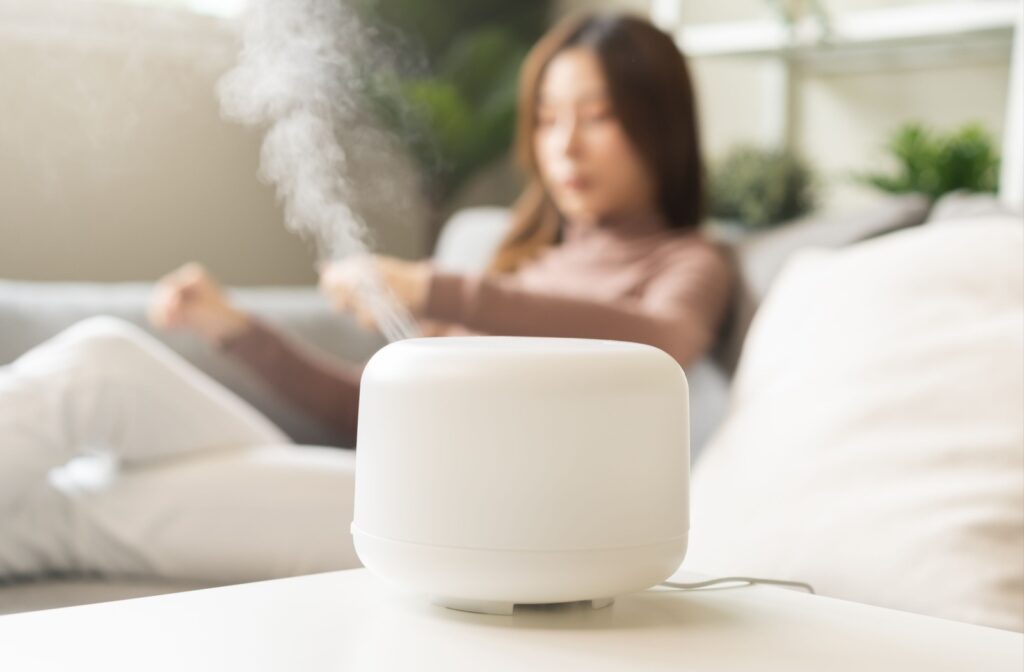The constant hum of a heater in winter or an air conditioner in summer can make your home comfortable. However, these systems often reduce the moisture in the air, leaving it dry. Dry air can affect more than just your skin—it can also be a significant factor in causing or worsening the symptoms of dry eye disease.
If you experience eye irritation indoors, you may wonder if changing your environment can help. A humidifier can be a simple and effective tool to help relieve dry eyes by adding moisture back into the air. This helps create a more comfortable space for your entire visual system and supports overall eye health.
How Dry Air Affects Your Eyes
You may notice that your eyes feel more scratchy or irritated when the air around you is dry. This happens because low humidity causes the tear film on the surface of your eyes to evaporate too quickly. This can leave your eyes unprotected and uncomfortable, especially when you spend a lot of time indoors.
Common Signs of Dry Eyes
Dryness can show up in several ways, and it’s not always just a feeling of dryness. Some common symptoms might point to this issue.
- A gritty or scratchy sensation
- Redness
- Stinging or burning feelings
- Blurred vision
- Watery eyes, which can be the body’s response to irritation from conditions like meibomian gland dysfunction
The Role of a Humidifier for Eye Comfort
A humidifier adds moisture back into your indoor air as a fine mist. By increasing humidity levels, the device helps slow down the evaporation of your tears. This simple change can help your eyes stay lubricated and feel more comfortable throughout the day.
Set the Right Humidity Level
For general comfort and eye health, an indoor humidity level between 30% and 50% is often suggested. You can use a small tool called a hygrometer to measure the humidity in your room. This allows you to adjust your humidifier’s settings for a balanced environment.
Choose a Humidifier for Your Space
Humidifiers come in different types and sizes to suit different needs. The most common choice is between models that produce a cool mist and those that create a warm mist. Your decision can depend on your personal preference and the room where you plan to use it.
Cool Mist vs. Warm Mist Humidifiers
Cool mist humidifiers are a popular choice, especially for homes with children or pets, as they don’t use a heating element. Warm mist models boil water to release a soothing steam, which some people prefer in colder months. Both types effectively add moisture to the air and can help reduce dryness.

Nighttime Relief & Humidifiers
Many people find their dry eye symptoms feel more pronounced when they wake up. This often happens because your eyes lose moisture overnight while you sleep. Running a humidifier in your bedroom helps maintain a more consistent level of humidity.
If you continue to experience discomfort despite these changes, a comprehensive eye exam can help identify the factors contributing to your symptoms.
More Ways to Find Dry Eye Relief
A few other simple habits can also support your eye health and comfort. These practices work well alongside using a humidifier to manage dry eye discomfort.
- Remember to blink regularly, especially when dealing with digital eye strain.
- Take breaks from your computer or phone—every 20 minutes, look at something 20 feet away for 20 seconds.
- Stay hydrated by drinking plenty of water throughout the day.
- Ask your eye doctor about rewetting drops that can provide temporary relief.
Managing dry eye discomfort often involves a combination of approaches, from adjusting your environment to adopting new habits. If you’re looking for personalized solutions for your dry eye symptoms, a conversation with an eye care professional can provide clarity. At Vision One Boise, we use a careful, tech-driven approach to understand your unique eye health needs. Schedule a consultation with our optometrist in Boise to assess your situation and create a personalized plan to help your eyes feel better.



